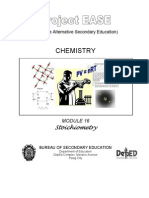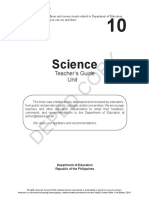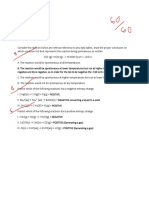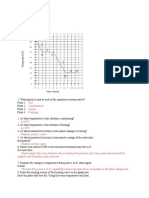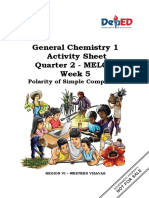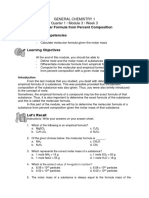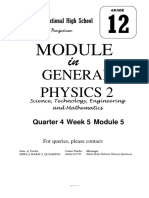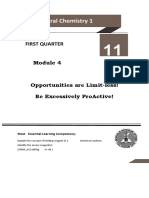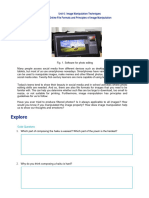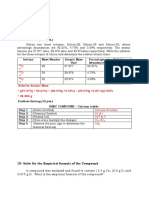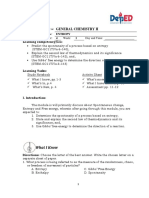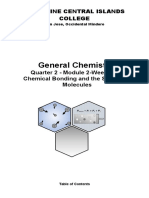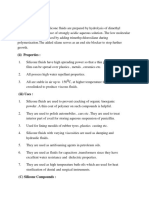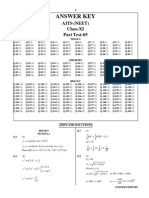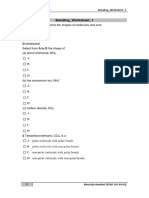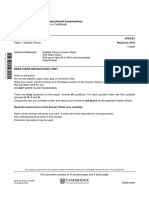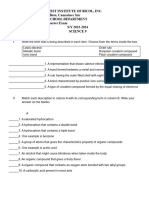Chem.g12 q2w7 Module3 Pamplona
Uploaded by
Raymalyn MalynChem.g12 q2w7 Module3 Pamplona
Uploaded by
Raymalyn MalynRepublic of the Philippines
Department of Education
Regional Office IX, Zamboanga Peninsula
12 Zest for Progress
Z Peal of artnership
General Chemistry 1
Quarter 2 - Module 3
Covalent Bonds, Lewis
Structures and Molecular
Geometry
Name of Learner: ___________________________
Grade & Section: ___________________________
Name of School: ___________________________
Module Covalent Bonds, Lewis
Structures and Molecular
3 Geometry
What I Need to Know
Covalent bonding occurs when pairs of electrons are shared by atoms. Atoms will covalently
bond with other atoms in order to gain more stability, which is gained by forming a full electron shell.
By sharing their outer most (valence) electrons, atoms can fill up their outer electron shell and gain
stability. Nonmetals will readily form covalent bonds with other nonmetals in order to obtain stability,
and can form between one to three covalent bonds with other nonmetals depending on how many
valence electrons it poses. Although it is said that atoms share electrons when they form covalent
bonds, they do not usually share the electrons equally.
This module will provide you with information and simple activities that will help you
demonstrate an understanding of covalent bond formation in terms of atomic properties.
After going through this module, you are expected to:
1. Apply the octet rule in the formation of molecular covalent compounds
(STEM_GC11CB-IId-g-76)
2. Write the formula of molecular compounds formed by the nonmetallic elements of
the representative block (STEM_GC11CB-IId-g-77)
3. Draw Lewis structure of molecular covalent compounds (STEM_GC11CBIId-g-78)
4. Describe the geometry of simple compounds (STEM_GC11CB-IId-g-81)
What’s In Score____/14
You were equipped with the basic knowledge about the number of protons, electrons and
valence electrons from the previous lesson. Try this activity for some learning adventure in connection
with the new topic on covalent bonds.
ACTIVITY 1. Bonding Basics of Covalent!
Directions: Use the Periodic Table in supplying the required data in Table 1.
Q1. Complete the chart for each element.
Table 1.Elements with Valence Electrons
Element # of Protons # of Electrons # of Valence Electrons
Carbon
1
Chlorine
Hydrogen
Directions: Identify the Lewis dot structure of the covalent compounds. Choose
from the pool of Lewis dot structures given below. Write the letter of your answer on
the space provided before each number.
A. B. C.
________Q2. Hydrogen + Hydrogen
________Q3. Hydrogen + Oxygen
________Q4. Chlorine + Chlorine
________Q5. Oxygen + Oxygen D. E. F.
________Q6. Carbon + Oxygen
What’s New Score: ____/5
Activity 2. Write it the Lewis Way!
Directions: Complete Table 2 by choosing the correct answers from the box.
Nitrate (N03) Fluorine gas (F2) Benzene (C6H6) Ammonia (NH3)
Table 2. Chemical Name and Symbol (Covalent Compounds)
Lewis Structure Chemical Name and Symbol
Q7.
Q8.
Q9.
Q10. Draw Lewis Dot Structures for the following Covalent Compounds.O2 is done
for you as an example. Write your answer in the space provided in Table 3.
Table 3. Lewis Dot Structure
Compound Lewis Dot Structure
O2
2
NH3
H2O
Activity 3. Chemists’ Formula! Score ____/10
These are examples of covalent bonds and covalent compounds. Covalent
compounds also are known as molecular compounds. Organic compounds, such as
carbohydrates, lipids, proteins, and nucleic acids, are all examples of molecular
compounds. You can recognize these compounds because they consist of nonmetals
bonded to each other.
Directions: You are provided with a box containing the chemical formulas of
covalent (molecular) compounds. Write the correct chemical formula on the space
provided.
Write the Chemical Formula
Q11. Carbon tetrafluoride__________________
CCl4 P2O5 CF4
Q12. Silicon dioxide________________________
Q13. Phosphorous mononitride_____________
Q14. Carbon disulfide
Q15. Dinitrogen trichloride_________________ PN CS2 SiO2
Q16. Disulfur trioxide______________________
Q17. Sulfur dibromide___________________________
Q18. Boron trisulfide_______________________
Q19. Nitrogen trifluoride____________________ N2Cl3 C3N4 NF3
Q20. Tricarbon tetranitrogen________________
Score: ____/10
SBr2 BS3 S2O3
Activity 4. Shape your Molecules!
The shapes of molecules can be predicted from their Lewis structures by using the
VSEPR( Valence Shell Electron Pair Repulsion)model, which states that electron
pairs around a central atom will assume a geometry that keeps them as far apart
from each other as possible.
Direction: Use the Lewis structure of water, (H2O) to answer the following questions
below. Shade the square that correspond to your answer.
H2O Lewis Structure.Source: google.com
Q21. How many atoms and lone pairs surround the central oxygen?
1 atom + 1 lone pair 2 atoms + 2 lone pairs
Q22. What is the geometry of this molecule?
Tetrahedral Trigonal bipyramidal
Q23. What is the shape of the molecule?
bent linear
3
Q24. Now fill in the missing information in Table 4. NH3 (Ammonia) is done as an
example.
Table 4. Geometry of Simple Compounds
Compound Geometry Polar
( Yes or No)
NH3 TETRAHEDRAL Yes
SF6 _C_ A _ E _R _ _
CO2 L__EA_ .
PF5 B _ P _ _ A_ _ D _ L
What is it
COVALENT BONDS
A covalent bond, also called a molecular bond, is a chemical bond that involves
the sharing of electron pairs between atoms. These electron pairs are known as
shared pairs or bonding pairs, and the stable balance of attractive and repulsive
forces between atoms, when they share electrons, is known as covalent bonding.
Only when two atoms of the same element form a covalent bond are the shared
electrons actually shared equally between the atoms. When atoms of different
elements share electrons through covalent bonding, the electron will be drawn more
toward the atom with the higher electronegativity resulting in a polar covalent bond.
When compared to ionic compounds, covalent compounds usually have a lower
melting and boiling point, and have less of a tendency to dissolve in water. Covalent
compounds can be in a gas, liquid, or solid state and do not conduct electricity or
heat well. The types of covalent bonds can be distinguished by looking at the Lewis
dot structure of the molecule. For each molecule, there are different names for pairs
of electrons, depending if it is shared or not. A pair of electrons that is shared between
two atoms is called a bond pair. A pair of electrons that is not shared between two
atoms is called a lone pair.
The Octet Rule
The Octet Rule requires all atoms in a molecule to have 8 valence electrons-
-either by sharing, losing or gaining electrons--to become stable. For Covalent
bonds, atoms tend to share their electrons with each other to satisfy the Octet Rule.
It requires 8 electrons because that is the amount of electrons needed to fill a s- and
p- orbital (electron configuration); also known as a noble gas configuration. Each
atom wants to become as stable as the noble gases that have their outer valence
shell filled because noble gases have a charge of 0. Although it is important to
remember the "magic number", 8, note that there are many Octet rule exceptions.
Example:
As you can see in Figure 1 below, Phosphorus has only 5 electrons in its outer shell
(bolded in red). Argon has a total of 8 electrons (bolded in red), which satisfies the
Octet Rule. Phosphorus needs to gain 3 electrons to fulfill the Octet Rule. It wants
to be like Argon who has a full outer valence shell.
4
.
Figure1.Source: chem.libretexts.org
A single bond is when two electrons--one pair of electrons--are shared
between two atoms. It is depicted by a single line between the two atoms. Although
this form of bond is weaker and has a smaller density than a double bond and a
triple bond, it is the most stable because it has a lower level of reactivity meaning
less vulnerability in losing electrons to atoms that want to steal electrons.
Example 1: HCl
Below is a Lewis dot structure of Hydrogen Chloride demonstrating a single
bond. As we can see in Figure 2 below, Hydrogen Chloride has 1 Hydrogen atom and
1 Chlorine atom. Hydrogen has only 1 valence electron whereas Chlorine has 7
valence electrons. To satisfy the Octet Rule, each atom gives out 1 electron to share
with each other; thus making a single bond.
Figure 2. Source: chem.libretexts.org
A Double bond is when two atoms share two pairs of electrons with each
other. It is depicted by two horizontal lines between two atoms in a molecule. This
type of bond is much stronger than a single bond, but less stable; this is due to its
greater amount of reactivity compared to a single bond.
Example 2: Carbon Dioxide
Below is a Lewis dot structure of Carbon dioxide demonstrating a double bond.
As you can see in Figure 3 below, Carbon dioxide has a total of 1 Carbon atom and
2 Oxygen atoms. Each Oxygen atom has 6 valence electrons whereas the Carbon
atom only has 4 valence electrons. To satisfy the Octet Rule, Carbon needs 4 more
valence electrons. Since each Oxygen atom has 3 lone pairs of electrons, they can
each share 1 pair of electrons with Carbon; as a result, filling Carbon's outer valence
shell (Satisfying the Octet Rule).
5
Figure 3. Source: chem.libretexts.org
A Triple bond is when three pairs of electrons are shared between two atoms
in a molecule. It is the least stable out of the three general types of covalent bonds.
It is very vulnerable to electron thieves!
Example 3: Acetylene
Below is a Lewis dot structure of Acetylene demonstrating a triple bond. As
you can see in Figure 4 below, Acetylene has a total of 2 Carbon atoms and 2
Hydrogen atoms. Each Hydrogen atom has 1 valence electron whereas each Carbon
atom has 4 valence electrons. Each Carbon needs 4 more electrons and each
Hydrogen needs 1 more electron. Hydrogen shares its only electron with Carbon to
get a full valence shell. Now Carbon has 5 electrons. Because each Carbon atom has
5 electrons--1 single bond and 3 unpaired electrons--the two Carbons can share their
unpaired electrons, forming a triple bond. Now all the atoms are happy with their
full outer valence shell.
Figure 4. Source: chem.libretexts.org
Polar Vs. Nonpolar !
A Polar Covalent Bond is created when the shared electrons between atoms
are not equally shared. This occurs when one atom has a higher electronegativity
than the atom it is sharing with. The atom with the higher electronegativity will have
a stronger pull for electrons (Similiar to a Tug-O-War game, whoever is stronger
usually wins). As a result, the shared electrons will be closer to the atom with the
higher electronegativity, making it unequally shared.
Example: Water, Sulfide, Ozone, etc.
6
Figure 5. Source: chem.libretexts.org
As you can see in Figure 5 above, Oxygen is the big buff creature with the
tattoo of "O" on its arm. The little bunny represents a Hydrogen atom. The blue and
red bow tied in the middle of the rope, pulled by the two creatures represents--the
shared pair of electrons--a single bond. Because the Hydrogen atom is weaker, the
shared pair of electrons will be pulled closer to the Oxygen atom.
A Nonpolar Covalent Bond is created when atoms share their electrons
equally. This usually occurs when two atoms have similar or the same electron
affinity. The closer the values of their electron affinity, the stronger the attraction.
This occurs in gas molecules; also known as diatomic elements.
Examples of gas molecules that have a nonpolar covalent bond: Hydrogen gas
atom, Nitrogen gas atoms, etc.
Figure 6. Source: chem.libretexts.org
As you can see in Figure 6 above, Hydrogen gas has a total of 2 Hydrogen
atoms. Each Hydrogen atom has 1 valence electron. Since Hydrogen can only fit a
max of 2 valence electrons in its orbital, each Hydrogen atom only needs 1 electron.
Each atom has 1 valence electron, so they can just share, giving each atom two
electrons each.
7
What’s More Score: ____/7
ACTIVITY 5. Let’s Bond It!
Directions: Determine which molecules are polar and which molecules are nonpolar
given its Lewis structure. Write the letter of the correct answer on the space provided
before the number
A. B. C.
_____________________1. Oxygen gas (O2)
_____________________2. Hydrochloric acid (HCl)
_____________________3. Carbon dioxide (CO2)
Match each atom or molecule with its corresponding letter(s): Write your
answers on the space provided for.
COLUMN A COLUMN B
_____________4. Nitrogen gas a) Nonpolar covalent bond
_____________5. Argon b) Polar covalent bond
_____________6. Carbon monoxide c) Follows the Octet Rule
_____________7. Hydrogen gas d) Noble gas
What I Have Learned Score: ____/20
1. Apply the octet rule in the formation of the following covalent
compounds below. Write your answer on the box provided.
A. Cl2 B. CO2
2. Write the molecular formula of the following covalent compounds. Choose the
correct answer from the box.
O3 HCl CO2
H2O PCl3 CH3CH2OH
CH4 NH3 H2
__________1. Phosphorus trichloride
___________2. Ethanol __________6. Hydrogen chloride
__________3. Ozone __________7. Methane
__________4. Hydrogen __________8. Ammonia
__________5. Water __________9. Carbon dioxide
8
3. Draw the best Lewis Dot Structure for each of the following species and descrie each
Molecular Geometry. BeF2 is done for you. Write your answer in the box.
Tale 5. Lewis Structure and Molecular Geometry
Species Name Lewis Dot Structure Molecular Geometry
BeF2 linear
BCl3
CCl4
PBr5
SI6
Directions: Fill up this success criteria chart to assess your reaction about the
lessons in this module.
Success Criteria
Name______________
Evaluate your learning by placing a check mark in the face that represents your level of confidence.
Circulatory System Level of
Confidence
STATEMENTS
I can apply the octet rule in the formation of molecular covalent compounds
I can write the formula of molecular compounds formed by the nonmetallic
elements of the representative block.
I can draw Lewis structure of molecular covalent compounds.
I can describe the geometry of simple compounds.
What I Can Do
ACTIVITY 5. FILL ME! Score__/10
Directions: Fill in the graphic organizer, ALPHABOXES with the appropriate
words learned from the lesson about Covalent Bonds, Lewis Structures and
Geometry of Covalent Compounds. Write your answers in the box.
ALPHABOXES
1. Table 6.TOPIC: COVALENT BONDS
A B C D
_________________ _________________ _________________ _________________
E F G H
_________________ __________________ __________________ __________________
9
I J K L
_________________ __________________ __________________ __________________
M N O P
_________________ __________________ _________________ __________________
Q R S T
__________________ _________________ __________________ __________________
U V W X
__________________ __________________ _________________ __________________
Q31. Select 5 words from the alpha boxes and use it in constructing a paragraph
reflecting your significant learning about the topic in this module. Write your
answers in the space provided below.
________________________________________________________________________
_________________________________________________________________________________
________________ _________________________________________________________________
________________ _________________________________________________________________
__________________________________________________________________________________
Thank you for sharing your knowledge. Now, you can already answer the post-test
to evaluate how much you have learned from the module.
Assessment Score: ____/15
Directions: Read and understand each question and encircle the letter of the best
answer among the given choices.
1. Which element will have 5 electrons in its Lewis dot symbol?
A. Argon C. Carbon
B. Boron D. Phosphorus
2. Which of the following elements can only form one bond in a Lewis structure?
A. O C. H
B. C D. Al
3. Write the correct Lewis dot structure for O2. Which statement correctly describes
the structure of the whole molecule?
A. There is a double bond and four lone pairs.
B. There is a double bond and six lone pairs.
C. There is a single bond and four lone pairs.
D. There is a single bond and six lone pairs.
10
4. The electron pair in a C - F bond could be considered…
A. Closer to C because Carbon has a larger radius and thus exerts greater
control over the shared electron pair
B. Closer to F because Fluorine has a higher electronegativity than Carbon
C. Closer to C because Carbon has a lower electronegativity
D. An inadequate model since the bond is ionic
5. Which bond is the strongest?
A. carbon - Nitrogen triple bond C. carbon - Hydrogen bond
B. carbon - Nitrogen double bond D. carbon - Carbon triple bond
6. Which of the following represents a non-polar covalent bond?
A. H-O C. C-C
B. C-N D. Li-F
7. When does covalent bonding take place?
A. It takes place when atoms share electrons with one another.
B. It takes place when the attraction between atoms is strong.
C. It takes place when atoms collide with one another.
D. It takes place when atoms attain stability.
E. It takes place when atoms gain electrons.
8. Which of the following contains a covalent bond?
A. Li2O B. NaO3 C. Mg3N2 D. NaCl
9. What kind of bond will form between two oxygen atoms?
A. Single bond C. polar covalent bond
B. Double bond D. nonpolar covalent bond
10. Write a Lewis structure for the covalently bonded ion ClO2-.
A. C.
B. D.
11. Which Lewis structure below best represents B2Cl4
A. C.
B. D.
11
12. Which Lewis structure below is incorrectly paired with its
formula?
A. CH3NH2 = C. HCN =
B. C2H2 = H-C C-H D. C2H4 =
13. Which of the following elements is incorrectly paired with its
Lewis symbol?
A. arsenic = C. silicon =
B. rubidium = D. calcium =
14. Write the simplest Lewis structure for the molecule BrF3.
A. C.
B. D.
15. Which is the correct Lewis structure for the CCl4 molecule?
A. C.
D.
B.
12
Great job!
You have reach this far.
Take time to answer the succeeding pages for a little more exciting activities to enrich
what you have learned from this module.
Additional Activities Score: ____/8
Activity 10. Search for Covalent Compounds
Directions: You will look for at least 2 examples of covalent compounds that can be
found in nature or can be used in everyday life. They must include the following
information:
a. Chemical formula and chemical name of the covalent compound
b. Lewis Structure of the compound
c. Brief information about the use of the covalent compound
d. Molecular Geometry
Use the Table below for the presentation of your answers.
Chemical Name Chemical Lewis Brief Molecular
Formula Structure Information Geometry
1.
2.
0
1
References
Books
Chemistry Science and Technology Textbook (2004), Department of
Education
General Chemistry 1 Teaching Guide for Senior High School Published by the
Commission on Higher Education, 2016
Chairperson: Patricia B.
Licuanan, Ph.D.
Frontiers in Chemistry (2002) DIWA SCHOLASTIC PRESS INC.
Website
Common Covalent Compounds, (2019). Anne Marie Helmenstine, Ph.D. Anne Marie Helmenstine, Ph.D. Chemistry Expert, Retrieved September 4,2020
fromhttps://www.thoughtco.com/some-examples-of-covalent-compounds-603981
Covalent Bonds, Retrieved from https://chem.libretexts.org/Bookshelves/Physical_and_Theoretical_Chemist
ry_Textbook_Maps/Supplemental_Modules_(Physical_and_Theoretical_Chem istry)/Chemical_Bonding/Fundamentals_of_Chemical_Bonding/Covalent_Bo nds
How do single, double, and triple covalent bonds differ? Retrieved September 7, 2020 from https://socratic.org/questions/how-do-single-double-and-
triplecovalent-bonds-differ
Writing Lewis Structures for Covalent Compounds, Retrieved September 7, 2020 from
https://chem.libretexts.org/Courses/College_of_Marin/CHEM_114%3A_Introducto
ry_Chemistry/10%3A_Chemical_Bonding/10.05%3A_Writing_Lewis_Structures_for _Covalent_Compounds
Ionic Crystals from https://courses.lumenlearning.com/introchem/chapter/ioniccrystals/
lewis-wksht-key.pdf, https://meettheelements.files.wordpress.com/2014/03/lewiswksht-key.pdf
Naming and Writing Covalent (Molecular) Compounds from
http://www.mayfieldschools.org/Downloads/Naming%20and%20Writing%20Coval ent%20Compounds%20and%20KEY.pdf
Bonding Basics- Covalent Bonds
Retrieved September 9, 2020 from
https://www.buffaloschools.org/site/handlers/filedownload.ashx?moduleinstanceid=6486&da taid=34589&FileName=covalent%20bond%20worksheet.pdf
Worksheet Molecular shapes http://www.nhvweb.net/nhhs/science/maleksza/files/2013/03/Worksheet-15-a nswers.pdf
Development Team Mi Ultimo Adios
Mi último adiós
Writer: Fredelita Y. Pamplona ¡Adiós, Patria adorada, región del sol Ora por todos cuantos murieron sin ventura,
querida, Por cuantos padecieron tormentos sin igual,
Editors: Margie Lou C. Jacob, Perla del mar de oriente, nuestro perdido Por nuestras pobres madres que gimen su
amargura;
Laarni A. Adonis, Edén!
A darte voy alegre la triste mustia vida, Por huérfanos y viudas, por presos en tortura
Kathleen Joy B. Padilla Y fuera más brillante, más fresca, más
florida,
Y ora por ti que veas tu redención final.
Joly C. Baradero También por ti la diera, la diera por tu bien. Y cuando en noche oscura se envuelva el
cementerio
Reviewer: Sandy R. Albarico En campos de batalla, luchando con delirio, Y solos sólo muertos queden velando allí,
Otros te dan sus vidas sin dudas, sin pesar; No turbes su reposo, no turbes el misterio,
Illustrator: El sitio nada importa, ciprés, laurel o lirio, Tal vez acordes oigas de cítara o salterio,
Soy yo, querida Patria, yo que te canto a ti.
Layout Artist: Cadalso o campo abierto, combate o cruel
martirio,
Management Team: Lo mismo es si lo piden la patria y el hogar. Y cuando ya mi tumba de todos olvidada
No tenga cruz ni piedra que marquen su lugar,
Majarani M. Jacinto, CESO VI Yo muero cuando veo que el cielo se colora
Y al fin anuncia el día tras lóbrego capuz;
Deja que la are el hombre, la esparza con la
azada,
SDS-ZDS si grana necesitas para teñir tu aurora, Y mis cenizas, antes que vuelvan a la nada,
El polvo de tu alfombra que vayan a formar.
Vierte la sangre mía, derrámala en buen hora
Y dórela un reflejo de su naciente luz
Entonces nada importa me pongas en olvido.
Visminda Q. Valde, Ed.D Mis sueños cuando apenas muchacho Tu atmósfera, tu espacio, tus valles cruzaré.
Vibrante y limpia nota seré para tu oído,
ASDS adolescente,
Mis sueños cuando joven ya lleno de vigor, Aroma, luz, colores, rumor, canto, gemido,
Fueron el verte un día, joya del mar de Constante repitiendo la esencia de mi fe.
oriente,
Raymond M. Salvador, Ed.D Secos los negros ojos, alta la tersa frente, Mi patria idolatrada, dolor de mis dolores,
Querida Filipinas, oye el postrer adiós.
Sin ceño, sin arrugas, sin manchas de rubor
ASDs Ahí te dejo todo, mis padres, mis amores.
Ensueño de mi vida, mi ardiente vivo anhelo, Voy donde no hay esclavos, verdugos ni
¡Salud te grita el alma que pronto va a partir! opresores,
Donde la fe no mata, donde el que reina es
Juliet M. Magallanes, Ed.D ¡Salud! Ah, que es hermoso caer por darte
vuelo, Dios.
CID Chief Morir por darte vida, morir bajo tu cielo,
Y en tu encantada tierra la eternidad dormir. Adiós, padres y hermanos, trozos del alma
mía,
Si sobre mi sepulcro vieres brotar un día Amigos de la infancia en el perdido hogar,
Florencio R. Caballero,DTE Entre la espesa yerba sencilla, humilde flor, Dad gracias que descanso del fatigoso día;
Adiós, dulce extranjera, mi amiga, mi alegría,
Acércala a tus labios y besa al alma mía,
EPS-LRMDS Y sienta yo en mi frente bajo la tumba fría, Adiós, queridos seres, morir es descansar.
De tu ternura el soplo, de tu hálito el calor.
José Rizal, 1896
Sandy R. Albarico Deja que el sol, ardiendo, las lluvias evapore
Y al cielo tornen puras, con mi clamor en
EPS -Science pos;
Deja que un ser amigo mi fin temprano llore
Y en las serenas tardes cuando por mí
alguien ore,
¡Ora también, oh Patria, por mi descanso a
Dios!
You might also like
- GR 10 Exam Guidelines 2024 Eng (3) - 071159No ratings yetGR 10 Exam Guidelines 2024 Eng (3) - 07115947 pages
- General Chemistry 1 Activity Sheet Quarter 2-MELC 12 Week 6No ratings yetGeneral Chemistry 1 Activity Sheet Quarter 2-MELC 12 Week 69 pages
- Concentration Units, Mole Fractions, and Molality PDF50% (2)Concentration Units, Mole Fractions, and Molality PDF6 pages
- Chapter 11 Intermolecular Forces, Liquids, and Solids: Sections 11.1 - 11.3No ratings yetChapter 11 Intermolecular Forces, Liquids, and Solids: Sections 11.1 - 11.382 pages
- Module 10 Colligative Properties of SolutionsNo ratings yetModule 10 Colligative Properties of Solutions19 pages
- Q3 Module 2A - Nature of Solids and Phase Changes 1No ratings yetQ3 Module 2A - Nature of Solids and Phase Changes 134 pages
- Physical Science 11 - B and C Leah BagalihogNo ratings yetPhysical Science 11 - B and C Leah Bagalihog53 pages
- General Chemistry 2: Learning Activity SheetNo ratings yetGeneral Chemistry 2: Learning Activity Sheet55 pages
- 2lesson 5 Colligative Properties of SolutionsNo ratings yet2lesson 5 Colligative Properties of Solutions25 pages
- General Chemistry Module 1 Republic of The PhilippinesNo ratings yetGeneral Chemistry Module 1 Republic of The Philippines18 pages
- General Physics 2: San Fabian National High SchoolNo ratings yetGeneral Physics 2: San Fabian National High School10 pages
- Regional Team: Jay - Bernat001@deped - Gov.phNo ratings yetRegional Team: Jay - Bernat001@deped - Gov.ph6 pages
- STEM GeneralChem2 Q4 Mod7 W8 Cell PotentialNo ratings yetSTEM GeneralChem2 Q4 Mod7 W8 Cell Potential30 pages
- DepEd SHS STEM General Chemistry Modules Quarters 1-2 by CDO - PDFNo ratings yetDepEd SHS STEM General Chemistry Modules Quarters 1-2 by CDO - PDF27 pages
- Module 9 Stoichiometric Calculations For Reactions in SolutionNo ratings yetModule 9 Stoichiometric Calculations For Reactions in Solution22 pages
- Chem 1 Percentage Composition and Chemical FormulasNo ratings yetChem 1 Percentage Composition and Chemical Formulas10 pages
- General Chemistry: Pressure and Its Common UnitsNo ratings yetGeneral Chemistry: Pressure and Its Common Units15 pages
- GeneralPhysics1 - Q2 - Mod8 - Properties of An Ideal Gas and Ideal Gas LawNo ratings yetGeneralPhysics1 - Q2 - Mod8 - Properties of An Ideal Gas and Ideal Gas Law24 pages
- D. Newton's Law of Motion: (Not Directly Stated)No ratings yetD. Newton's Law of Motion: (Not Directly Stated)3 pages
- Chemical Bonding Board Level Assignment: 1. Which of The Following Has Maximum Bond Angle? HNo ratings yetChemical Bonding Board Level Assignment: 1. Which of The Following Has Maximum Bond Angle? H7 pages
- O MG C Na: A7 The Structures of Two Ionic Lattices Are Shown BelowNo ratings yetO MG C Na: A7 The Structures of Two Ionic Lattices Are Shown Below35 pages
- Nakhleh 1992 Why Some Students Don't Learn Chemistry100% (1)Nakhleh 1992 Why Some Students Don't Learn Chemistry6 pages
- Carbon and Its Compounds - Short Notes (Prashant Kirad)90% (10)Carbon and Its Compounds - Short Notes (Prashant Kirad)16 pages
- Cambridge International Examinations Cambridge Pre-U CertificateNo ratings yetCambridge International Examinations Cambridge Pre-U Certificate12 pages
- St. John The Baptist Institute of Bicol, Inc. San Juan, Bato, Camarines Sur Junior High School Department Third Quarter Exam S/Y 2023-2024 Science 9No ratings yetSt. John The Baptist Institute of Bicol, Inc. San Juan, Bato, Camarines Sur Junior High School Department Third Quarter Exam S/Y 2023-2024 Science 93 pages
- _A.P. Chemistry Unit 3_ Properties of Substances and MixturesNo ratings yet_A.P. Chemistry Unit 3_ Properties of Substances and Mixtures73 pages



